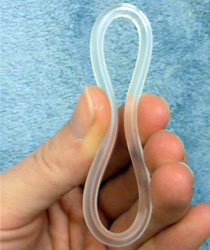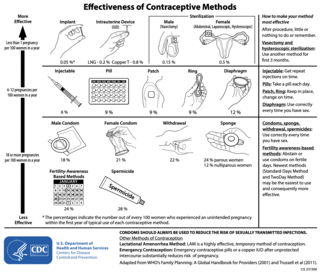Related Research Articles
Coitus interruptus, also known as withdrawal, pulling out or the pull-out method, is a method of birth control during penetrative sexual intercourse, whereby the penis is withdrawn from a vagina or anus prior to ejaculation so that the ejaculate (semen) may be directed away in an effort to avoid insemination.

Emergency contraception (EC) is a birth control measure, used after sexual intercourse to prevent pregnancy.

Fertility awareness (FA) refers to a set of practices used to determine the fertile and infertile phases of a woman's menstrual cycle. Fertility awareness methods may be used to avoid pregnancy, to achieve pregnancy, or as a way to monitor gynecological health.

The combined oral contraceptive pill (COCP), often referred to as the birth control pill or colloquially as "the pill", is a type of birth control that is designed to be taken orally by women. It is the oral form of combined hormonal contraception. The pill contains two important hormones: a progestin and estrogen. When taken correctly, it alters the menstrual cycle to eliminate ovulation and prevent pregnancy.
Calendar-based methods are various methods of estimating a woman's likelihood of fertility, based on a record of the length of previous menstrual cycles. Various methods are known as the Knaus–Ogino method and the rhythm method. The standard days method is also considered a calendar-based method, because when using it, a woman tracks the days of her menstrual cycle without observing her physical fertility signs. The standard days method is based on a fixed formula taking into consideration the timing of ovulation, the functional life of the sperm and the ovum, and the resulting likelihood of pregnancy on particular days of the menstrual cycle. These methods may be used to achieve pregnancy by timing unprotected intercourse for days identified as fertile, or to avoid pregnancy by avoiding unprotected intercourse during fertile days.

The diaphragm is a barrier method of birth control. It is moderately effective, with a one-year failure rate of around 12% with typical use. It is placed over the cervix with spermicide before sex and left in place for at least six hours after sex. Fitting by a healthcare provider is generally required.

Levonorgestrel is a hormonal medication which is used in a number of birth control methods. It is combined with an estrogen to make combination birth control pills. As an emergency birth control, sold under the brand names Plan B One-Step and Julie, among others, it is useful within 72 hours of unprotected sex. The more time that has passed since sex, the less effective the medication becomes, and it does not work after pregnancy (implantation) has occurred. Levonorgestrel works by preventing ovulation or fertilization from occurring. It decreases the chances of pregnancy by 57–93%. In an intrauterine device (IUD), such as Mirena among others, it is effective for the long-term prevention of pregnancy. A levonorgestrel-releasing implant is also available in some countries.

A contraceptive patch, also known as "the patch", is a transdermal patch applied to the skin that releases synthetic oestrogen and progestogen hormones to prevent pregnancy. They have been shown to be as effective as the combined oral contraceptive pill with perfect use, and the patch may be more effective in typical use.
Male contraceptives, also known as male birth control, are methods of preventing pregnancy that are used by males or people who produce sperm. The main forms of male contraceptives available today are condoms, vasectomy, and withdrawal, and these methods combined make up less than one-third of global contraceptive use.
Progestogen-only pills (POPs), colloquially known as "mini pills", are a type of oral contraceptive that contain synthetic progestogens (progestins) and do not contain estrogens. They are primarily used for the prevention of undesired pregnancy, although additional medical uses also exist.

A contraceptive vaginal ring is a type of hormonal insert that is placed in the vagina for the purpose of birth control. The rings themselves utilize a plastic polymer matrix that is inlaid or embedded with contraceptive drug. This drug, often one or two hormones, is absorbed directly through the bloodstream through the cells that line the vaginal wall. Some vaginal rings contain both an estrogen and a progestin, which are available in Europe and the United States. Other vaginal rings contain just progesterone. The progesterone-only ring is only available in Latin America, exclusively for postpartum breastfeeding parents.

Hormonal contraception refers to birth control methods that act on the endocrine system. Almost all methods are composed of steroid hormones, although in India one selective estrogen receptor modulator is marketed as a contraceptive. The original hormonal method—the combined oral contraceptive pill—was first marketed as a contraceptive in 1960. In the ensuing decades, many other delivery methods have been developed, although the oral and injectable methods are by far the most popular. Hormonal contraception is highly effective: when taken on the prescribed schedule, users of steroid hormone methods experience pregnancy rates of less than 1% per year. Perfect-use pregnancy rates for most hormonal contraceptives are usually around the 0.3% rate or less. Currently available methods can only be used by women; the development of a male hormonal contraceptive is an active research area.

There are many methods of birth control that vary in requirements, side effects, and effectiveness. As the technology, education, and awareness about contraception has evolved, new contraception methods have been theorized and put in application. Although no method of birth control is ideal for every user, some methods remain more effective, affordable or intrusive than others. Outlined here are the different types of barrier methods, hormonal methods, various methods including spermicides, emergency contraceptives, and surgical methods and a comparison between them.
Long-acting reversible contraceptives (LARC) are methods of birth control that provide effective contraception for an extended period without requiring user action. They include injections, intrauterine devices (IUDs), and subdermal contraceptive implants. They are the most effective reversible methods of contraception because their efficacy is not reliant on patient compliance. The typical use failure rates of IUDs and implants, less than 1% per year, are about the same as perfect use failure rates.

A contraceptive implant is an implantable medical device used for the purpose of birth control. The implant may depend on the timed release of hormones to hinder ovulation or sperm development, the ability of copper to act as a natural spermicide within the uterus, or it may work using a non-hormonal, physical blocking mechanism. As with other contraceptives, a contraceptive implant is designed to prevent pregnancy, but it does not protect against sexually transmitted infections.

Birth control, also known as contraception, anticonception, and fertility control, is the use of methods or devices to prevent unintended pregnancy. Birth control has been used since ancient times, but effective and safe methods of birth control only became available in the 20th century. Planning, making available, and using human birth control is called family planning. Some cultures limit or discourage access to birth control because they consider it to be morally, religiously, or politically undesirable.

CycleBeads is a visual tool that was developed by the Institute for Reproductive Health at Georgetown University. This device helps women use the Standard Days Method, a fertility awareness-based family planning method.

Drospirenone/ethinylestradiol/levomefolic acid (EE/DRSP/LMF), sold under the brand name Beyaz among others, is a combination of ethinylestradiol (EE), an estrogen, drospirenone (DRSP), a progestogen, antimineralocorticoid, and antiandrogen, and levomefolic acid (LMF), a form of vitamin B9, which is used as a birth control pill to prevent pregnancy in women. The formulation contains folate as the calcium salt of levomefolic acid to lower the risk of complications such as fetal neural tube defects should the medication fail as a form of birth control. EE/DRSP/LMF was approved for use by the US Food and Drug Administration (FDA) in September 2010.

Ethinylestradiol/etonogestrel, sold under the brand names NuvaRing among others, is a hormonal vaginal ring used for birth control and to improve menstrual symptoms. It contains ethinylestradiol, an estrogen, and etonogestrel, a progestin. It is used by insertion into the vagina. Pregnancy occurs in about 0.3% of women with perfect use and 9% of women with typical use.
Elina Berglund Scherwitzl is a Swedish particle physicist and entrepreneur who, together with her husband Raoul Scherwitzl, has developed an app to indicate the days when a woman is most fertile. It can be used both for birth control and for planning a family. The app is marketed as Natural Cycles, which is also the name of the company the couple founded to produce it in 2013.
References
- 1 2 Emma Lundin (7 November 2016), "Could an algorithm replace the pill?", The Guardian
- ↑ Daniela Walker (4 October 2016), "Can an algorithm replace the pill?", Wired
- ↑ Claire Cohen (20 June 2015), "Could an app replace the contraceptive pill?", Daily Telegraph
- 1 2 3 Maddy Savage (7 August 2017). "The Swedish physicist revolutionising birth control". BBC News.
- ↑ Thorbecke, Catherine (August 12, 2018). "FDA approves marketing for a contraception app for the 1st time". ABC News. Retrieved August 13, 2018.
- ↑ Lomas, Natasha. "Natural Cycles gets $30M for its EU-certified "digital contraception"". TechCrunch. Retrieved 2017-12-15.
- ↑ "A Swedish app that wants to replace your birth control pill has raised $30 million to expand to the US". Business Insider. Retrieved 2017-12-15.
- ↑ Cohen, Claire (2016-04-13). "Could an app really replace the contraceptive pill?". The Telegraph. ISSN 0307-1235 . Retrieved 2017-12-15.
- ↑ "P-piller i appform – varför satsar någon pengar på det?". Breakit (in Swedish). Retrieved 2017-12-15.
- 1 2 "It's Tough Being the First Birth Control App". 2019-04-01. Retrieved 2019-06-12.
- ↑ Berglund Scherwitzl E, Lundberg O, Kopp Kallner H, Gemzell Danielsson K, Trussell J, Scherwitzl R (December 2017). "Perfect-use and typical-use Pearl Index of a contraceptive mobile app". Contraception. 96 (6): 420–425. doi:10.1016/j.contraception.2017.08.014. PMC 5669828 . PMID 28882680.
- 1 2 Hough, Amy; Bryce, Maggie; Forrest, Simon (2018-07-21). "Social media and advertising natural contraception to young women: the case for clarity and transparency with reference to the example of 'Natural Cycles'". BMJ Sex Reprod Health. 44 (4): bmjsrh–2018–200110. doi:10.1136/bmjsrh-2018-200110. ISSN 2515-1991. PMID 30032124. S2CID 51707769.
- ↑ "Would you trust a smartphone app as a contraceptive?". NHS. 15 April 2016. Retrieved 10 February 2019.
- ↑ "Hyped birth control app Natural Cycles has been reported to the authorities - after 37 unwanted pregnancies". nordic.businessinsider.com. Archived from the original on 2018-08-14. Retrieved 2018-08-14.
- ↑ "Contraceptive app Natural Cycles is under investigation over unwanted pregnancies". Business Insider .
- ↑ "Discover the Science | Digital Birth Control". 5 August 2020.
- ↑ "Contraceptive app investigated over 'misleading' claims about its accuracy" . The Independent. Archived from the original on 2022-06-18. Retrieved 2018-08-14.
- ↑ Sudjic, Olivia (2018-07-21). "'I felt colossally naive': the backlash against the birth control app". The Guardian. Retrieved 2018-08-14.
- 1 2 "The first "birth control app" was just approved by the FDA. Its transparency and effectiveness are in question". Vox. Retrieved 2018-08-14.